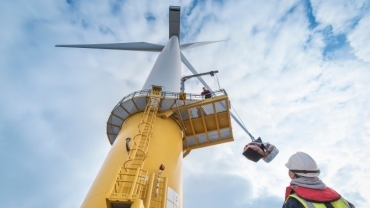
Handled right, Australia's energy transition has the power to transform the way we live, turbocharge our economy and achieve our climate and environmental goals. But only if we take a coordinated, people-centric response.
Australia is a global leader in energy and resources, boasting some of the most sophisticated workforces in the world. We’re the fourth largest mining country (after China, the US and Russia), and a top-five producer of gold, iron ore, lead zinc and nickel. Our energy sector is a massive success story - we are the number one exporter of LNG, a world leader in solar PV and we’re at the forefront of the growing hydrogen industry.
What, then, is stopping us from becoming a new energy superpower? We have all the raw materials and natural advantages.
Take lithium, for example. Australia’s lithium reserves are currently the second largest in the world, and we’re the number one lithium producer. With demand for lithium set to jump 11-fold in the next three decades (thanks to lithium-ion batteries for electric vehicles and stationary storage), Australia is set to really scoop the pool in lithium if we act now.
And that’s just lithium. The new energy transition is all about moving to an energy system that’s more technologically and commercially complex than ever before, and one of Australia’s greatest strengths is our ability to deal with technologically sophisticated assets and machinery. We’ve also proved to be adept at the commercial and financial aspects, and this is pivotal to succeeding in the future energy economy.
If we get this right, we're in a prime position to diversify our economy, and seize the opportunities presented by decarbonisation. So where do we start?
Putting people at the heart of the new energy transition
The move to a carbon neutral economy is only achievable if we take a people-centric approach. This means focusing on evolving Australia’s workforce and putting people at the heart of the energy transition.
Decarbonisation will have a big impact on Australia’s workforces and communities, especially in our regions, where the Centre of Policy Development predicts a handful of local government areas will bear the brunt of the transition. Around 300,000 Australian jobs connected to coal, oil and gas exports will be impacted by 2050.
Yet our transition effort needs a lot of people and it needs increasingly sophisticated skills, many of which are only found in our existing workforce. Traditional short-term solutions - immigration, offshoring, automation - will have limited impact, and our long-term solutions are hampered by a lack of interest from students and a severe shortage of educators. Our energy transition, therefore, hinges on managing our workforce effectively.
3 tips for managing workforce evolution
PwC’s workforce and skills team has been working with Governments around the country on planning for the skills we need for renewable energy, resources, hydrogen and advanced manufacturing. Firstly, consider what we’ve learned:
We don’t have time to waste
We need to proactively prepare our people, regions, organisations and higher education and vocational training systems so that our workforce can adapt to the inevitable shift in energy demand. The good news is: if we get started today then we have time to adequately prepare.
We need investment
Both Government and the private sector will together need to fund a combination of:
- compensation payments for those who lose their jobs and can't be reemployed
- redeployment costs such as training and guaranteeing the transfer of benefits and entitlements, and
- long-term adaptation policies for our impacted communities and regions.
We need to take accountability
A myriad of players from government, industry, business, unions, employees, and the community need to come together on this. However, a single entity needs to drive and coordinate the change. We recommend establishing an independent organisation in Australia with the responsibility and authority to drive change. This would be similar to the Energy Security Board or the International Olympic Committee, and the many Just Transition authorities that have been created overseas.
So, how do we achieve a successful transition here in Australia? At PwC we’ve boiled it down to three practical steps:
1. Take a systems transformation view
Taking a whole-of-system view will ensure that no single element is optimised to the detriment of the overall system. It can also reveal potentially counter-intuitive pathways to decarbonisation and transition. For example, do we look at ways to invest and create jobs where the people who need them are, rather than where the best solar or wind resources are? Do we invest in carbon capture and storage, not for its environmental merit, but because it is a stepping stone for our oil and gas workforce? And how creative can we be in our thinking on renewable energy zones and energy hubs?
2. Put people at the heart of all decision-making
When we're talking about 300,000 workers being impacted, what we're really talking about are people, and we need to consider these people every step of the way to earn the trust of Australian workers and communities. The interventions need to be coordinated but also specifically tailored to each region in a way that respects their needs, culture and identity.
One way to achieve this is to create an overarching deal at the Federal level. This will bring together the various agencies and guide individual state or council plans, helping address broader community challenges such as improving availability of childcare, community health and safety, and other support services.
Our Australian deal must enable our traditional energy workers and communities to evolve identities that are not just included, but are intrinsic to the new energy economy, and give us the people we need to deliver the energy transition. This will require community engagement on a massive scale.
3. Focus on skills and training
Australia’s mining industry is second-to-none when it comes to embedding health and safety practices. In just the same way, we’re perfectly capable of delivering new technical and specialist skills training. And the sector already contains many of the transferable skills we’ll need, including those in data and analytics. We recommend:
- introducing new formal programs, pathways and partnerships between industry, Government, TAFEs and Universities to bring more people into our sector, and invest in keeping them up-to-date.
- recognising that many transferable people and skills are ‘locked in’ to their existing organisations and their current roles, we need to think differently and find ways to upskill, reskill and incentivise our existing workforce to be part of the change.
- creating common standards and work practices that enable our workforce to be more mobile and flexible. We need people to be able to move in, out, and within our industry and organisations with minimum friction. This will also help us leverage diversity and build on the 39% female representation in the clean energy workforce by targeting workers in regional areas who can help support their families, but who perhaps weren’t previously employed in hydrocarbon industries.
Daunting, but doable
Ultimately, it’s within our power to make Australia’s energy transition a success. We have amazing natural resources, plus a proven track record when it comes to establishing a world-class energy sector. And we’ve seen plenty of goodwill when it comes to decarbonisation.
Now is the time to lean in and turn that goodwill into action.
Contact us


















